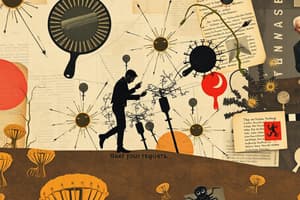Podcast
Questions and Answers
Which experiment definitively disproved the theory of spontaneous generation by demonstrating that microorganisms come from the environment and not from non-living matter?
Which experiment definitively disproved the theory of spontaneous generation by demonstrating that microorganisms come from the environment and not from non-living matter?
- Nitrogen Fixation Experiment
- Swan-Neck Flask Experiment (correct)
- Meat and Maggot Experiment
- Boiled Broth Experiments
Normal microbiota are harmful microorganisms that cause diseases in their host.
Normal microbiota are harmful microorganisms that cause diseases in their host.
False (B)
List three ways in which microbes are commercially beneficial.
List three ways in which microbes are commercially beneficial.
Food production, antibiotic production, and biofuel creation
In the binomial nomenclature system, the ______ name is always capitalized, while the species name is written in lowercase.
In the binomial nomenclature system, the ______ name is always capitalized, while the species name is written in lowercase.
Match the bacterial morphology with its description:
Match the bacterial morphology with its description:
Flashcards
Biogenesis
Biogenesis
Life arises from pre-existing life forms.
Pathogens
Pathogens
Microbes that cause disease.
Bacteria
Bacteria
Prokaryotic, peptidoglycan cell walls, various shapes.
Normal Microbiota
Normal Microbiota
Signup and view all the flashcards
Genus
Genus
Signup and view all the flashcards
Study Notes
- Microbiology focuses on understanding the microbial world and its interactions with humans
Debate Over Spontaneous Generation vs. Biogenesis
- Spontaneous generation is the idea that life can emerge from non-living substances
- Biogenesis is the principle that living organisms arise from pre-existing life forms
Key Experiments Resolving the Debate
- Meat and Maggot experiment showed maggots originate from flies, disproving spontaneous generation
- Boiled broth experiments demonstrated that cloudiness resulted from airborne microbes
- Swan-neck flask experiment permitted air entry but trapped microbes, confirming microbes originate from external environment
Applications and Commercial Benefits of Microbiology
- Environmental applications include biodegradation, bioremediation, nutrient recycling, and nitrogen fixation
- Industrial benefits include food production through fermentation, biofuel production, and enzyme creation
- Medical applications involve antibiotic production, probiotics, and vaccine development
- Agricultural applications include plant growth promotion and pest control
Host-Microbe Interactions
- Normal microbiota are beneficial microbes aiding digestion, immunity, and vitamin production
- Pathogens are microbes that cause disease
- Normal microbiota is crucial for preventing pathogen colonization and maintaining overall health
Major Microbial Groups
- Bacteria are prokaryotic microorganisms with peptidoglycan cell walls and various shapes
- Archaea are prokaryotic microorganisms lacking peptidoglycan and often thriving in extreme environments
- Eukarya includes fungi, protozoa, algae, and helminths
- Non-living agents include viruses (DNA/RNA), viroids (RNA), and prions (proteins)
Morphology of Bacteria
- Common bacterial shapes include coccus, bacillus, spirillum, spirochete, vibrio, and pleomorphic forms
- Common arrangements include diplo-, strepto-, staphylo-, tetrads, and sarcinae
Nomenclature
- Genus is capitalized, and species is lowercase; both are italicized (e.g., Escherichia coli)
- Strains are variants within a species
Studying That Suits You
Use AI to generate personalized quizzes and flashcards to suit your learning preferences.
Description
Explore the historical debate between spontaneous generation and biogenesis in microbiology. Learn about experiments that disproved spontaneous generation, highlighting the origin of life from pre-existing life forms. Discover the various environmental, industrial, and medical applications of microbiology.




